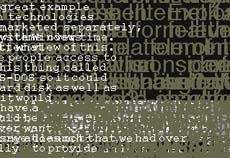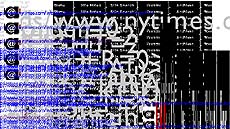December 3, 1998

By MATTHEW MIRAPAUL
While most visual artists aspire to change the way we see the world, some achieve this goal not by what they show us but how they show it. When Artists Build Their Own Browsers
We tend to take for granted that, whether we are using Internet Explorer or Netscape Navigator, what appears in the browser window is presented with some degree of consistency from monitor to monitor, including works of online art.
But two new artist-developed programs that are freely accessible on the Web serve to remind us of the presence of the raw digital materials that lurk behind the browser window, the extensive handiwork that goes into shaping them for human consumption, and the arbitrariness of the conventions for Web page display.
Mark Napier's Shredder, launched Thursday, is a plain-looking little Web site that takes just about any URL you care to enter and transforms the Web page's text, graphics and underlying HTML code into a mangled but dazzling display.
Andi Freeman's funksolegrind, launched in late September, is a small program written in Java that requires downloading and installation. When opened, the browser-style program takes any Web page's textual elements, including the underlying code for links, and spews the letters randomly across the screen. As the lines of type overlap, they fade into a dark gray oblivion.
Artists in emerging media are often fond -- perhaps overly so -- of using their chosen medium to point out its unique characteristics. In the digital realm, approaches have ranged from deliberately unfriendly user interfaces to jodi.org's impressionistic washes of ASCII characters that have been stripped of their informational purpose.
Both Napier and Freeman were inspired by Web Stalker, a rather revelatory example of this especially self-conscious genre. Developed by a trio of British artists, Web Stalker is an alternative browser that ignores the medium's graphical elements, focusing instead on the structural relationships between linked texts.
Although Web Stalker effectively challenges the notion of what constitutes a browser, its primary visual payoff is a diagram of a selected site, a practical map of circles and lines. Napier and Freeman follow a different route: they appropriate and destroy, although the results can be quite appealing.
Napier, a digital artist in New York who maintains the Potatoland.org site, considered building
Detail of funksolegrind's transformation of a page from Microsoft's site.
his own browser but ultimately rejected the idea and constructed the Netscape- and Explorer-compatible Shredder instead.
"It's more fun -- sneakier -- to work from inside the system and create a completely unexpected aesthetic within a familiar context," Napier said. "And with no downloads or Java toolkits, it's just more accessible. I think of the Web as a public place, and I like to think of my artwork as public art; it's a seamless part of the Web environment."
Napier held on to the metaphor of the electronic shredder in developing the PERL-scripted filter that produces a new rendition of the selected page. It serves as a subversive reminder that the Web may be a publishing medium but one that certainly isn't print.
Napier mused: "You're not dealing with paper you can shred here, so what happens when you try? What's similar and what's different between this world and the physical world we're coming from?"
As a page flows through the Shredder, vertical strips of text stream down the screen. Chopped-up images and enlarged chunks of text soon join the collage. Although the color scheme is derived from the original page, a background hue may emerge as the dominant one. Similarly, a tiny graphic element may become huge.
After the transformation, many of the links remain live, so it is actually possible to surf through Shredder. In some instances, flashing graphics like ad banners continue to blink; when the animation is something as tonally sophisticated as the artist Robbin Murphy's Osiris, the shredded results can resemble a Stuart Davis painting that has come alive.
With its appropriation of "found objects" -- credit-card logos, vacation snapshots -- Shredder's output also shares a sensibility with Robert Rauschenberg's "combines," which incorporated anything from old tires to torn envelopes.
But Napier professed admiration for a different artistic inspiration: Jackson Pollock, currently the subject of a retrospective exhibit at the Museum of Modern Art. "I love the organic quality he gets from the medium, even when he was working with roofing tar or latex," Napier said. "And for me, what happens [in Shredder] with the images and the text starts to become organic -- somewhat random but not mindlessly random."
For some reason, commercial sites like Download.com and the Microsoft home page, as well as portal venues like Yahoo!, produce some of the most eye-popping results when Shredded.
While it is enjoyable to restyle these graphic-design disasters into visually arresting pages, the most perverse pleasure provided by Shredder is its ability to convert sites devoted to such inexplicably popular public figures as Madonna into digital confetti.
Funksolegrind offers a similar experience, even though its monochromatic, image-free results are not as advanced as Shredder's. It may also require some extra effort; although it functioned smoothly on a Macintosh computer, repeated attempts to install the program on a PC failed.
Freeman, a multimedia developer in London, did not reply to e-mail or faxed messages, but the "read me" file accompanying his program stated that "it will not help you to navigate the Internet... Rather use funksolegrind to generate, improve or remove." The browser is the first in a series called "sHrd" -- pronounced "shred," of course -- and future editions are likely to handle graphics and sound.
The Shredder's version of arts@large.
At present, there are no plans to create a new and improved version of Web Stalker, the browser that inspired both Shredder and funksolegrind. In an e-mail message, Matthew Fuller, one of Web Stalker's trio of developers, said the program "has pretty much achieved what it set out to establish: a specific intervention into the browser wars and the techno-aesthetic cartel of Explorer and Navigator."
He added: "We have found that there are thousands of reasons for people wanting to use Web sites in the 'wrong' way. Web Stalker helps them to do this -- and more important, to dream of and invent new ones."
For Napier, the time for dreaming is over. Shredder, he said, is "a way of waking people up to the possibilities of the medium aesthetically."
If you don't agree, of course, you can take this page's URL and shred it.


